Tomb statuette of a smoking figure
Author:
D.H. Duco (Don Duco)
Original Title:
Grafbeeld rokende figuur
Publication Year:
1993
Journal:
Periodiek Vereniging Rembrandt
Description:
Worth knowing facts about a pre-Columbian statue from the Chapalilla culture from the southern Nayarit region in Mexico, dating from the third century AD, depicting a seated smoker.
In pre-Columbian times the use of tobacco in Mesoamerica has already played a prominent role (note 1). On temple reliefs, smoking gods appear as images, which provide evidence for the mystical significance attributed to smoke, in particular tobacco smoke. But it is not only the temple reliefs where this smoking is depicted. The depiction of the smoker also occurs in burial gifts, while the tobacco pipe itself can also form part of the grave gifts for the deceased, albeit in rare cases.
Thanks to generous support from the Vereniging Rembrandt (Rembrandt Association), museum Pijpenkabinet in Leiden has recently been able to acquire a smoking figure from the third century AD (Fig. 1). The tomb figure is the oldest imaginable and most pronounced example to show tobacco smoking. It dates from pre-Columbian times, from an area where the tobacco originally grows. The magnificent seated smoker is one of the finest of its kind and although it is an archaeological object, the condition is perfect.

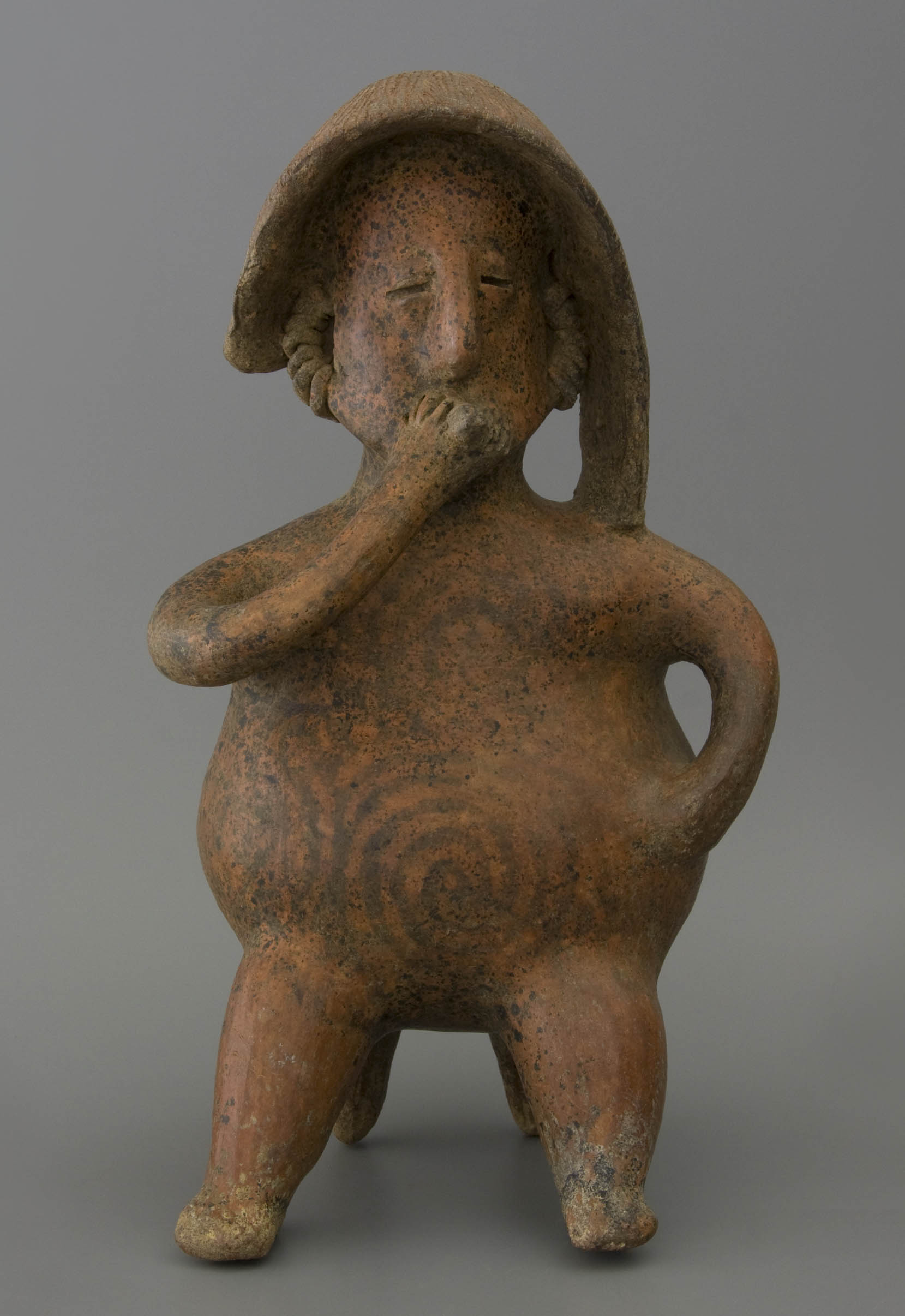
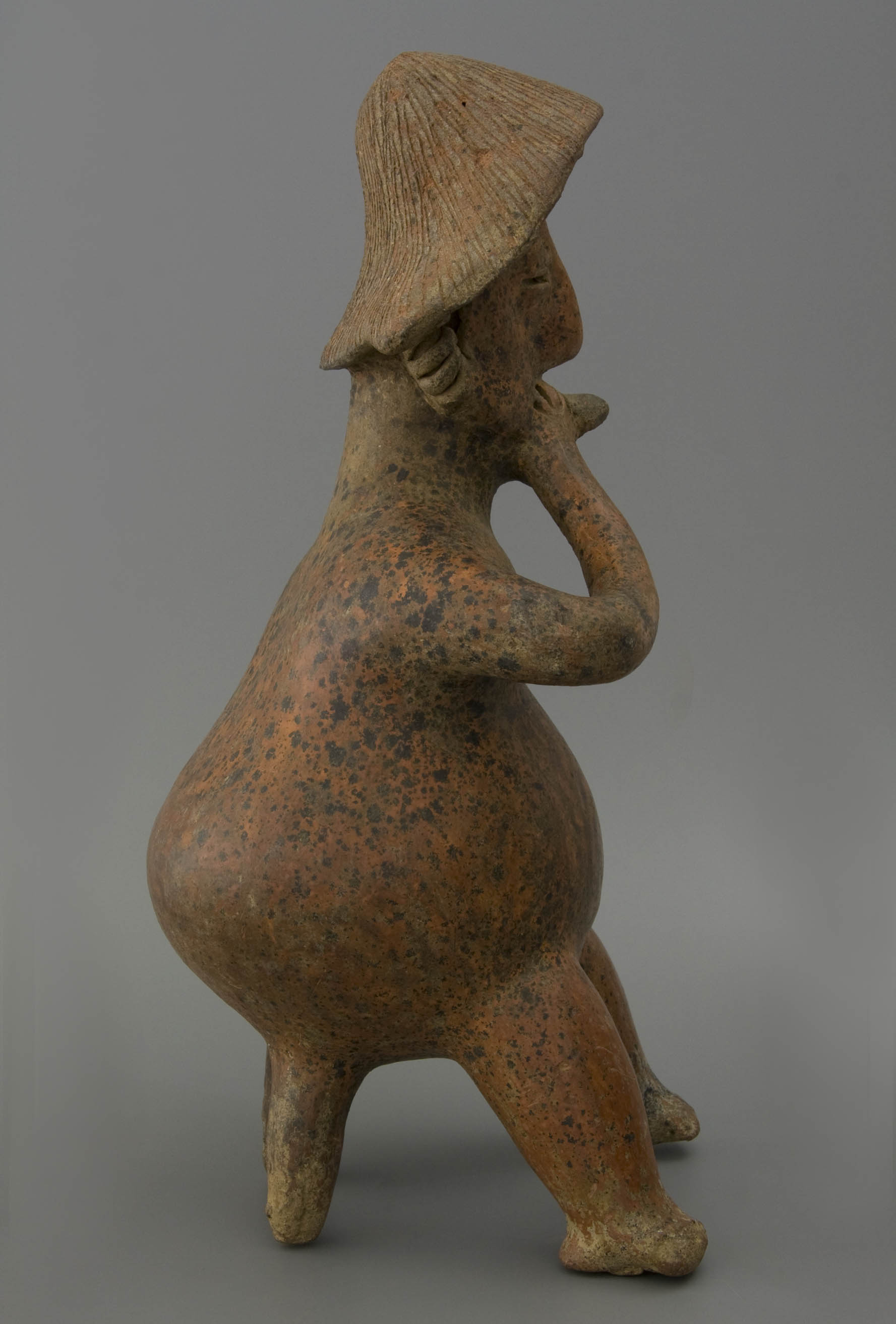
The sculpture originates from the Nayarit culture, from a region on the Pacific coast in Mexico. The main culture-related characteristics of this tomb statuette form the convex to pear-shaped silhouette of the body, which occurs more often in the southern Nayarit region. In addition, the flat face with pinched eyes and a curved nose is characteristic for this tribe, as are the multiple earrings, which run along the entire auricle. Unexpectedly, the than prevailing bracelets around the upper arms are missing. Finally, the powerful legs with hollow soles are a characteristic. Such seated figures are often placed on a stool with two legs, such as in this case.
The design of statuettes in the Nayarit culture is usually strongly focused on the front. The figure is modelled from the front view and has thus acquired a rather two-dimensional character. That is why the stool has only two legs, it provides support rather than being a meticulous representation of a seating furniture. A remarkable detail shows the right hand, in which the figure holds a tobacco roll turned into a cigar. This hand is modelled from two sides and therefore has eight fingers, four on each side. With this detail the maker shows a hesitant beginning of the three-dimensional concept. Fingers and eyes are indicated by pressing lines in the clay with a spatula.
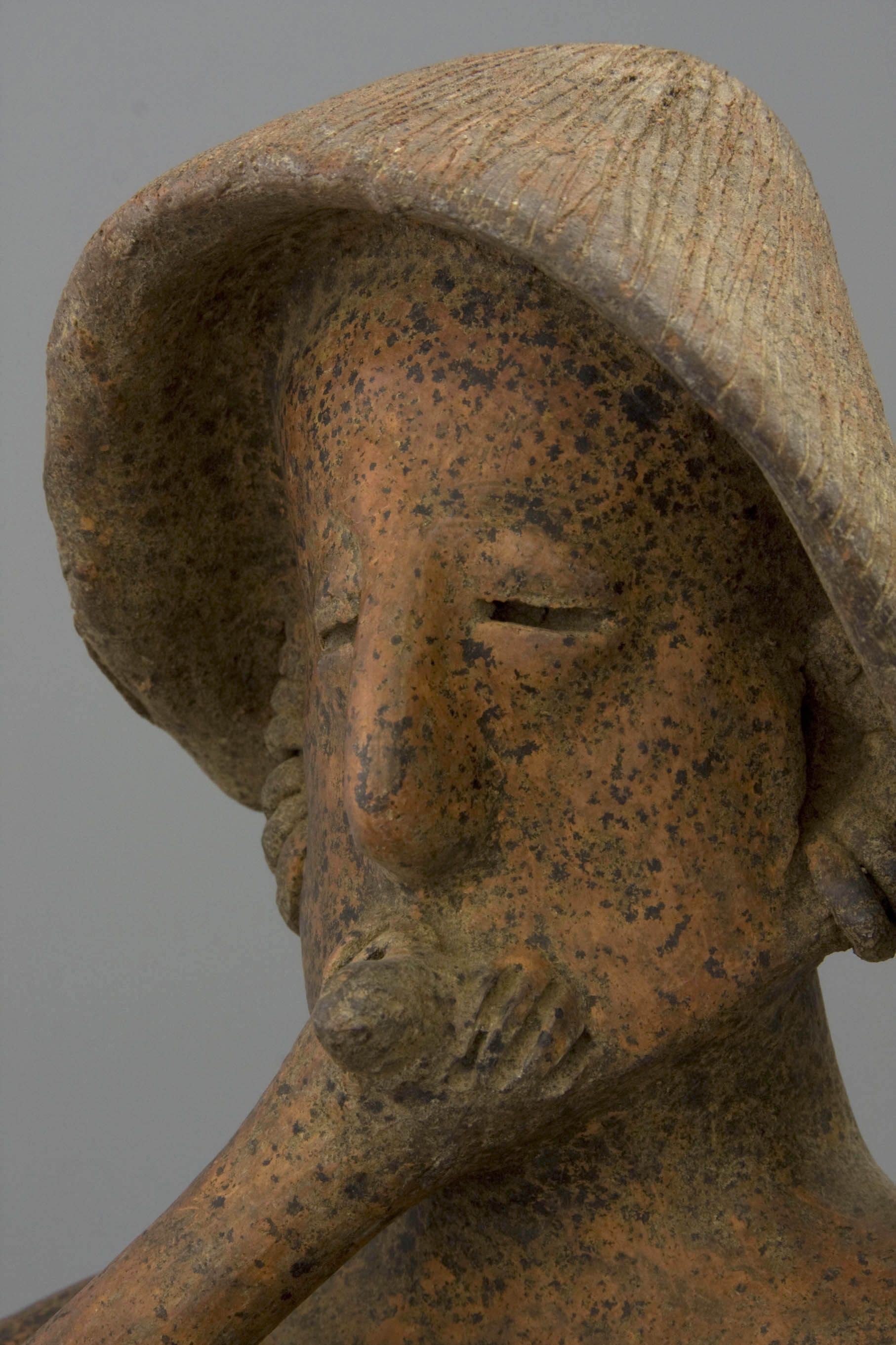
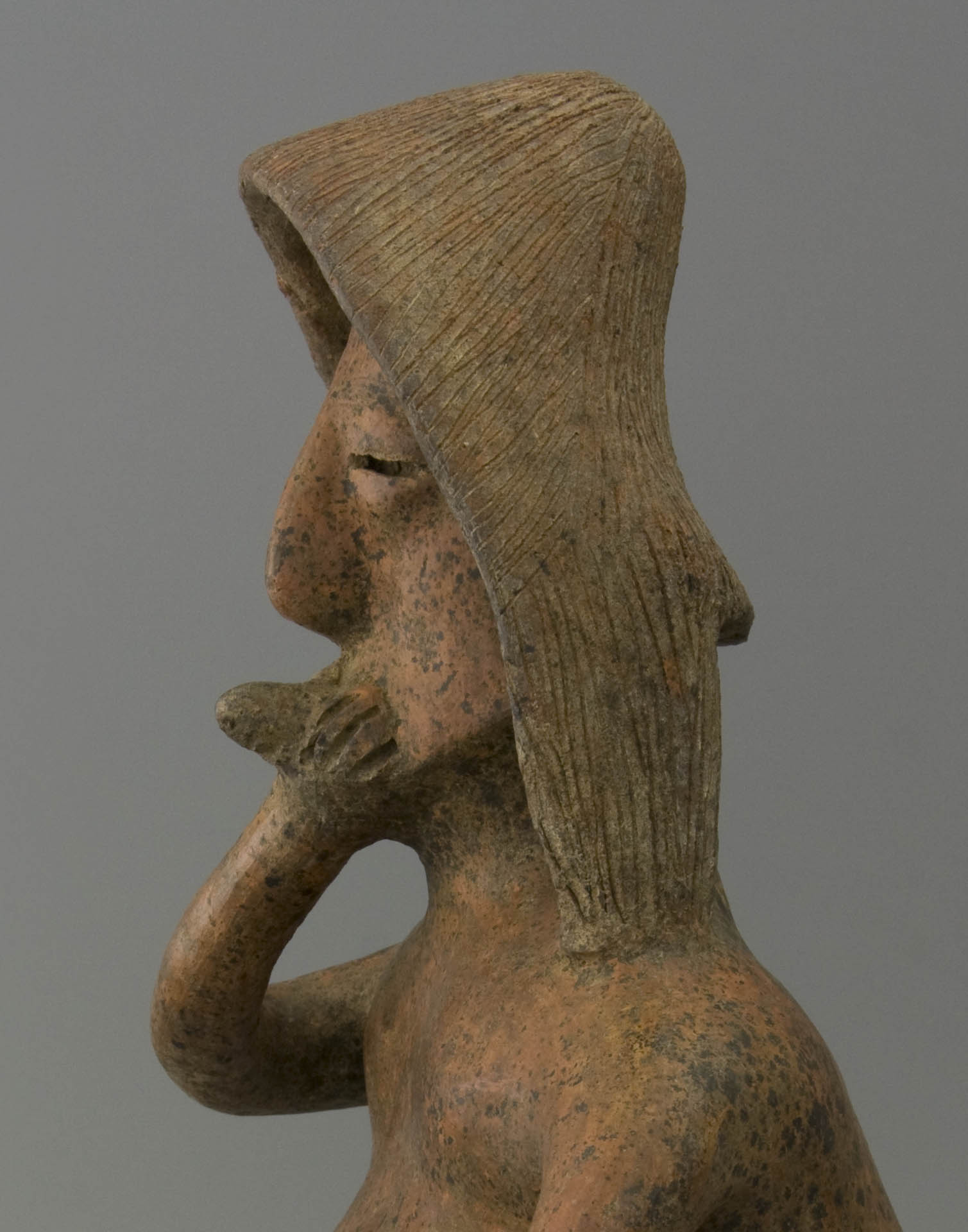
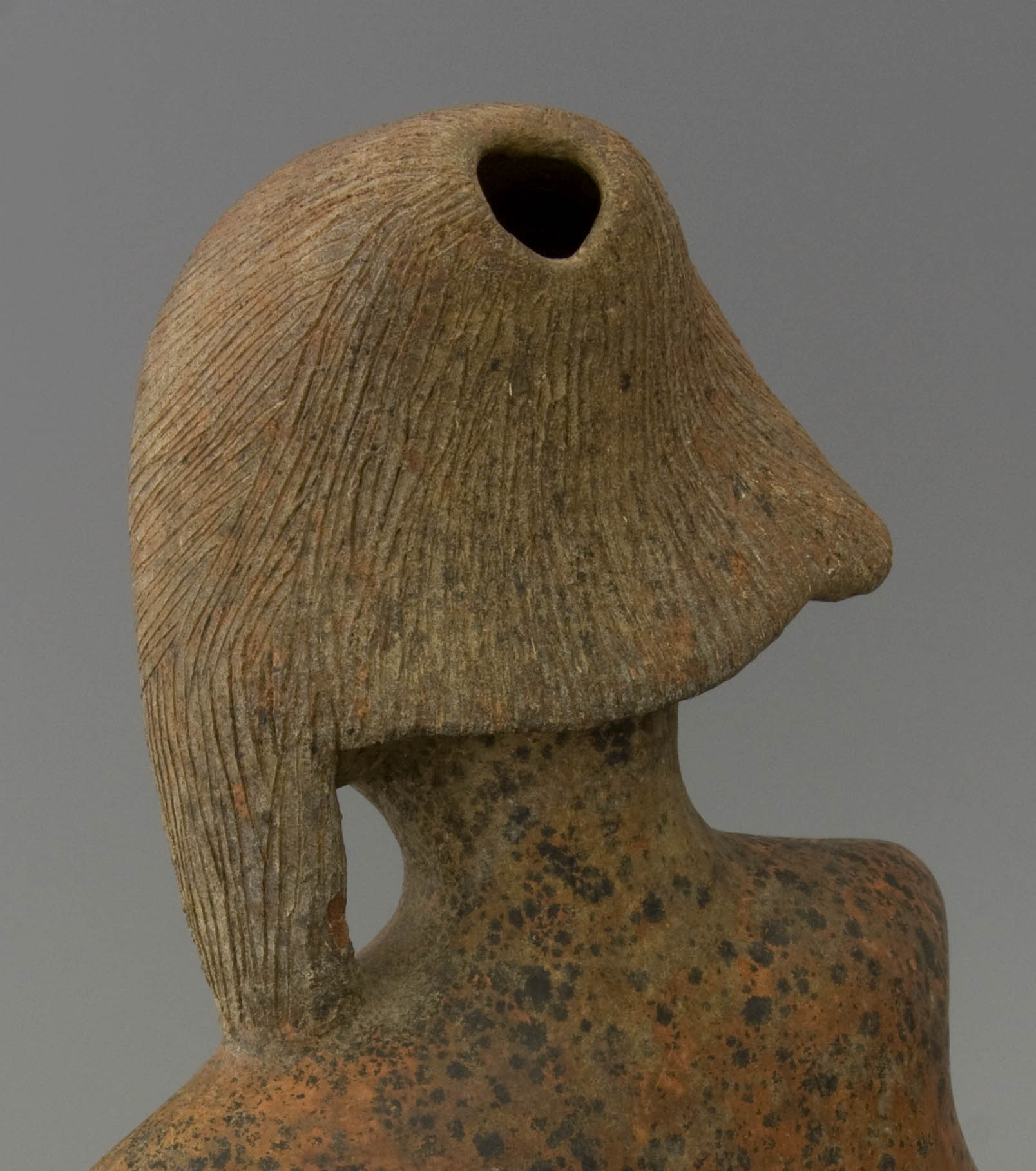
The haircut got a remarkable treatment. In general, this is kept short and sometimes shows a lock of braided hair or a small piece of jewellery. In this image the haircut has the form of a hat or hood, a broad lock hanging from the shoulder, so that an asymmetrical contour playfully breaks the rigid pose of the statue. This part of the image is unpolished with incised lines suggesting the hairs, in strong contrast to the rest of the object. That is because the main surface is provided with a polished slip. On the chest and belly of the statuette spiral shapes are applied with black dye. The figure has no sex characteristics, as sometimes corresponding statuettes show. We can assume, however, that it is a man.
Seen from the side, the image shows a strong vertical axis, which rises from the legs of the stool. The well-muscled legs of the smoker, ending in the characteristic small feet with hollow soles, are prominent in this silhouette. The bulbous body may have been inspired by ceramic objects from the Colima culture, which developed simultaneously in the southern border area of Nayarit. This tomb statue shows both ceramic-technical and stylistic similarities.
Like most of the objects that were handed down from pre-Columbian times, this image was also found in a shaft tomb. The shaft tomb is commonly used in Colima, Nayarit and Jalisco. A vertical shaft of up to fifteen meters leads to the bottom of the tomb (note 2). At the end one or more burial chambers are connected. Each room can contain one or more statuettes as an additional grave gift, sometimes up to a number of twenty. The style of these figures can be different. A remarkable fact about these shaft tomb complexes is that the associated settlements have not yet been found.
Shaft grave images or more specific grave images of smokers can be subdivided into three main forms. The most common is the straight-back type, the rigid statue with the strongest frontality, usually representing a person with a fairly flat body (note 3). In addition, a more curved posture is known: the back has a clear bulge at the lower part of the body, so that the head of the sitter comes forward and the vertical axis seen from the side changes into a circular shape (note 4). Finally, there is the present figure, of which I have not yet found a second example. Characteristic in this specimen is the combination of verticality with round shapes. In all three types, while the modelling is concentrated on the front, the finish is equally careful from all sides. If perception was still focused, the craftsmanship proves that the maker was now ready for a three-dimensional approach.

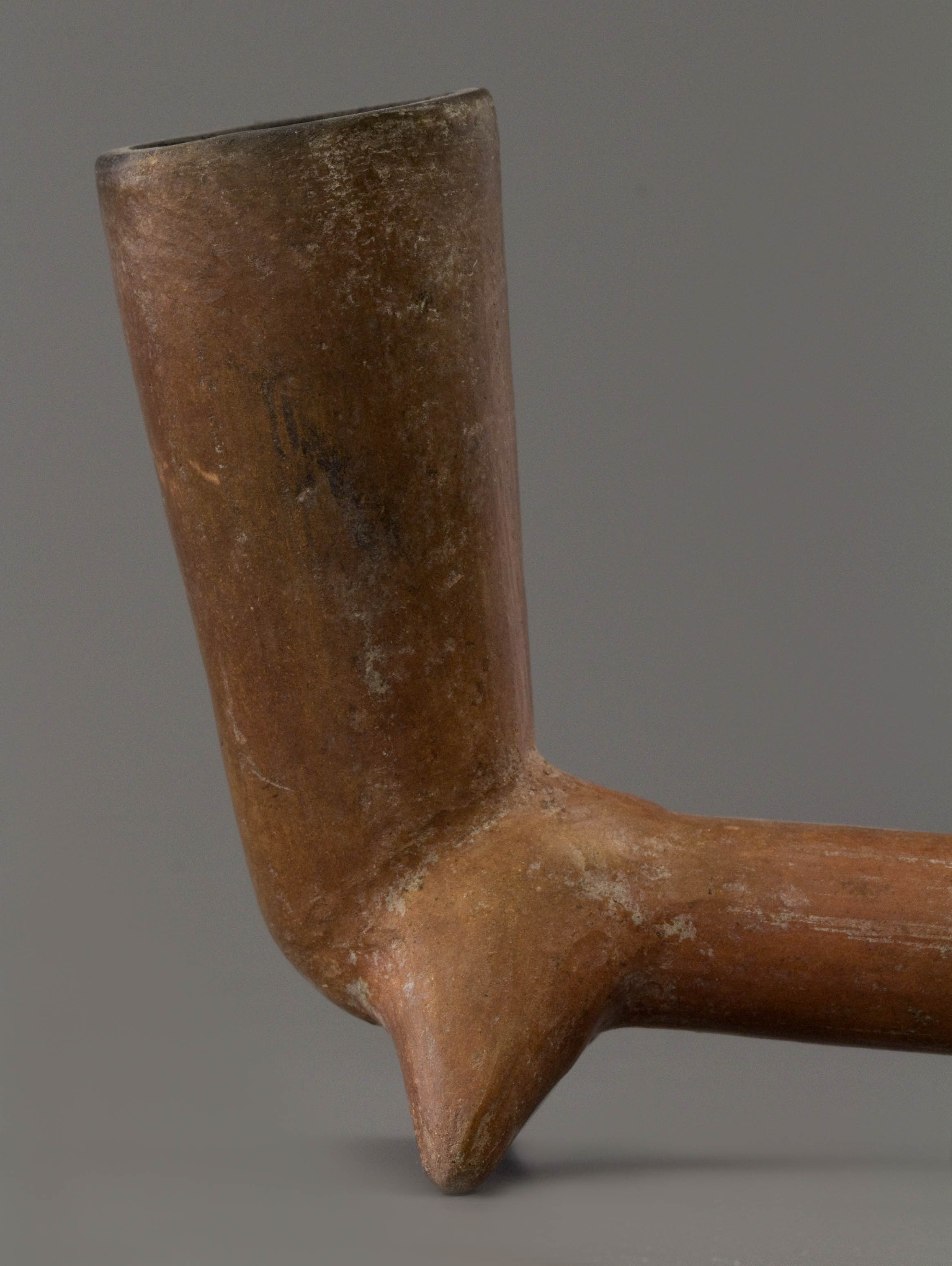
It is possible that this object, placed in the grave, also fulfilled the function of vessel. The fat belly shape gives the item a substantial content. An oval opening is located at the top, in the centre of the hairstyle or hood. Of course, this opening is necessary as a ventilation hole because the object would otherwise collapse in the kiln during firing. When used as a vessel, this beautifully rounded opening could be used as a mouth rim.
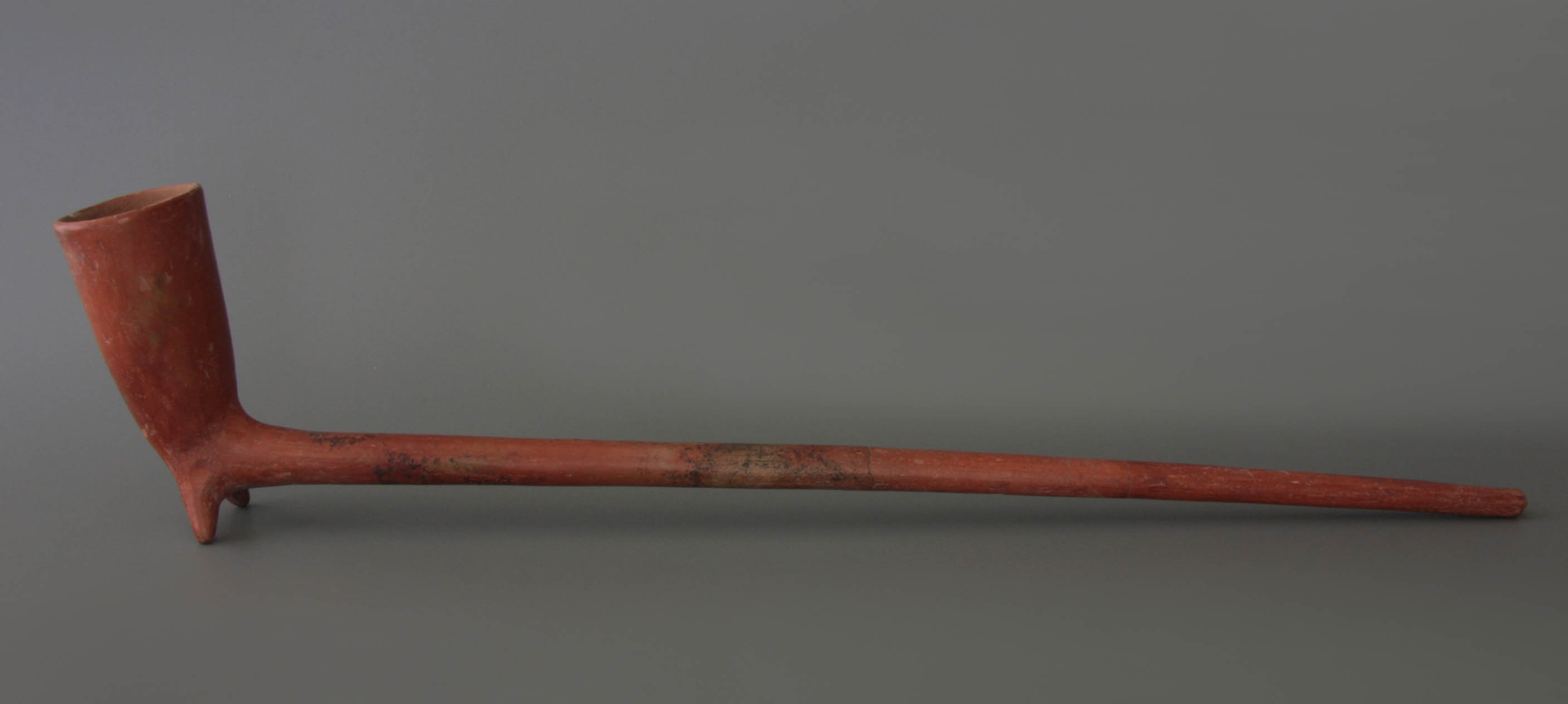


The ceramics in the Nayarit culture were well developed. The red-baking clay was dug up in the vicinity of the workshop. After modelling, the chalky surface is finished with a ferrous slip, which has been poured over the object and then polished with a smooth stone. From a technical perspective, the object has a strong relationship with the ceramics of the adjacent Colima and Jalisco culture. The cultures of Western Mexico are known for such red-baking ceramics, in professional circles known as San Sebastian-red as a generic name.
As a smoking offering, a sculpture that presents tobacco use in its earliest form, this object is of great value to the Pijpenkabinet. The image is the emblematic introduction of smoking in the story that the museum collection tells about tobacco use. It is an illustration of the smoking culture, of which the tobacco itself has gone up in smoke. Only the pipes are left as evidence.
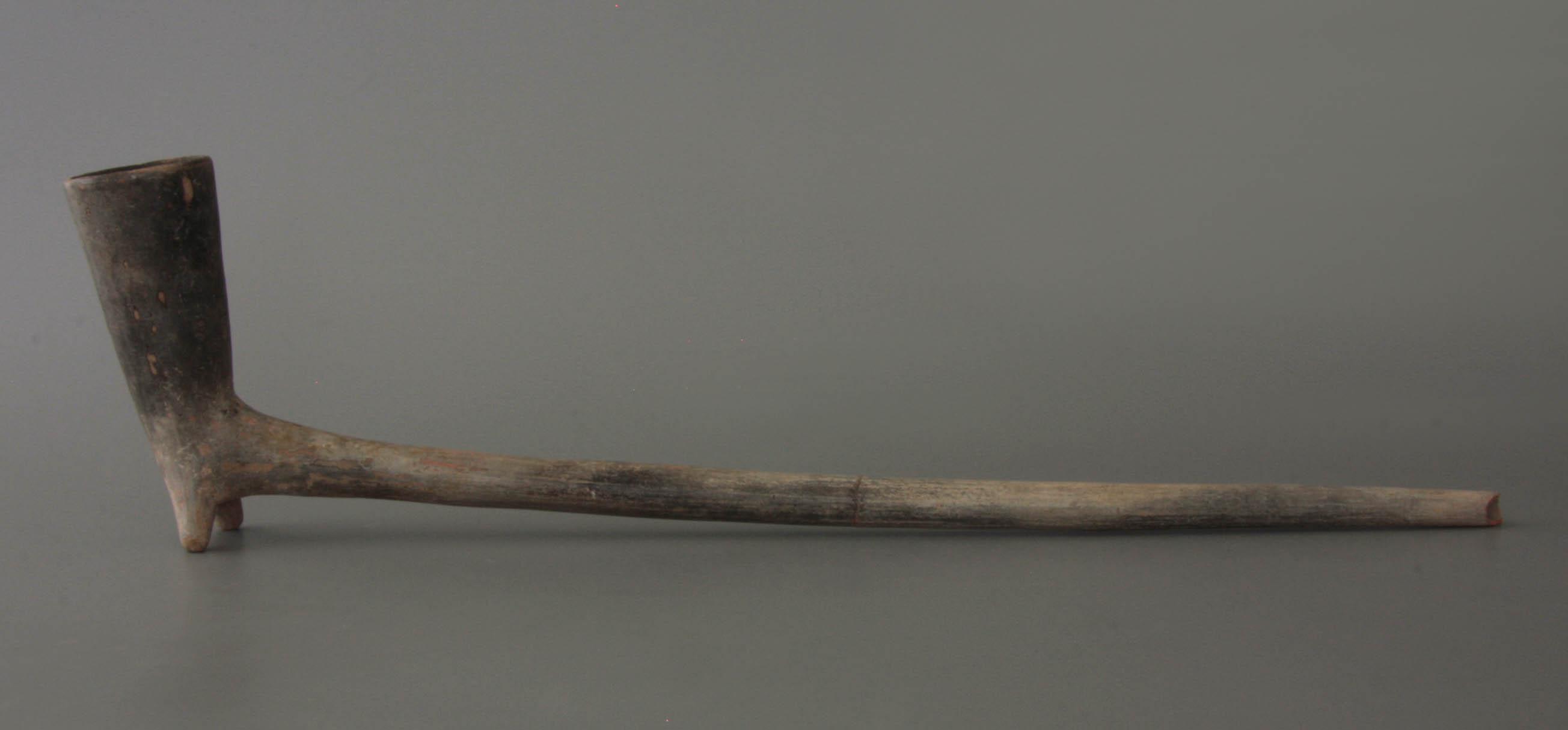

Pre-Columbian pipes are well represented in the collection of the Pijpenkabinet. The shape variety ranges from simple models, which are clearly recognizable as pipes for us, to more sculptural tobacco pipes. The pipes from the Tarrasque culture depicted here (Fig. 2-4), apparently the most fervent pipe smokers in pre-Columbian times, are a good example of this style. Similar to the tomb statues, these pipes have the same ceramic technique: hand shaped and finished with a red, polished slip. These products have also been found as a tribute in graves, sometimes even as a pair. In addition, another tobacco pipe type exists, designed after nature. A representative example is the pipe copied to the shape of the mescaline cactus (Fig. 5-8). The bowl suggests the spherical cactus body and the stem represents an aerial root. Sometimes the flower, which comes in a trumpet-shaped chalice when flowering, is even indicated. Besides, many variant shapes have been made, whereby a decoration is added to the standard pipe model consisting of a bowl and a stem.
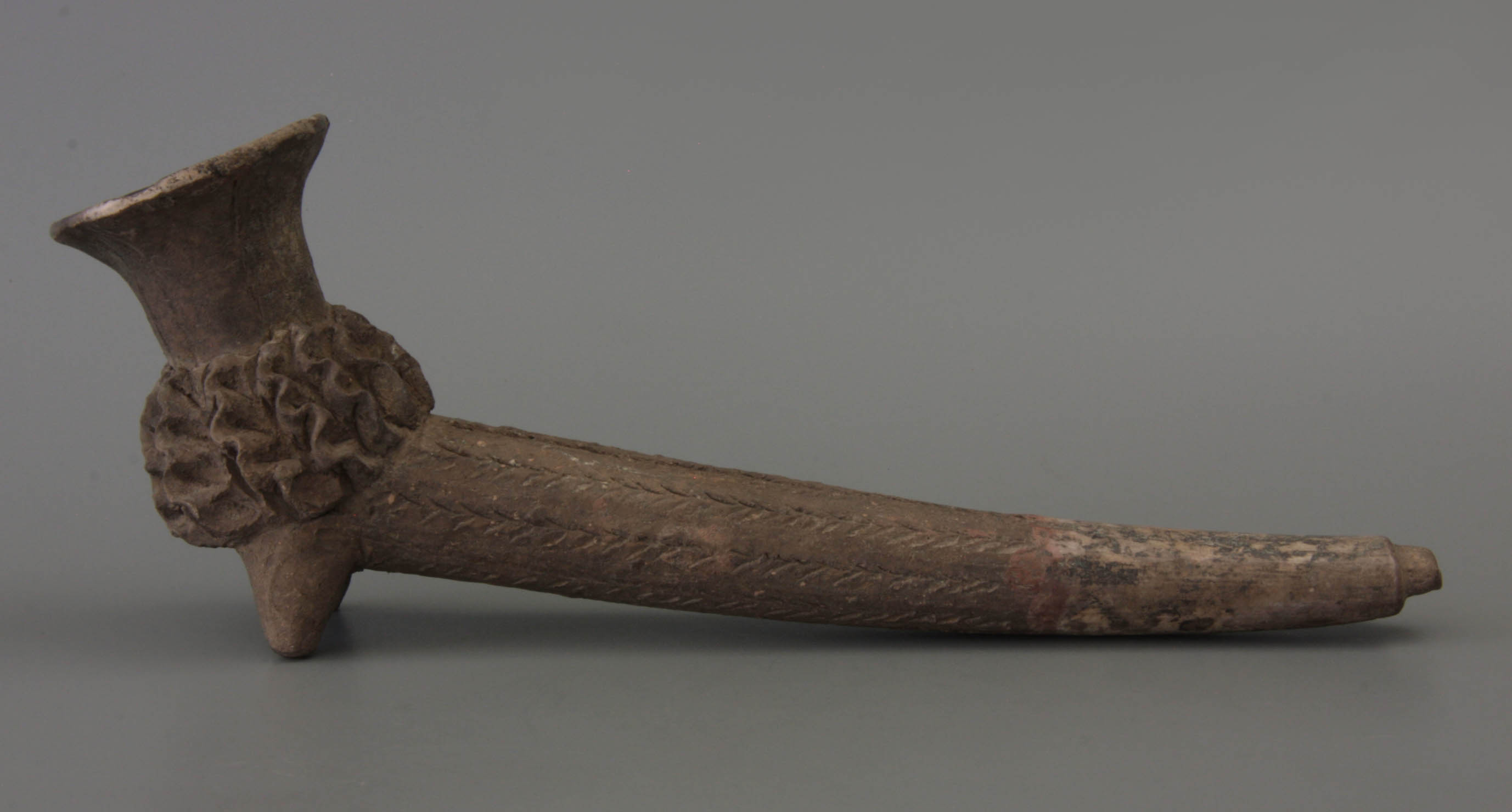
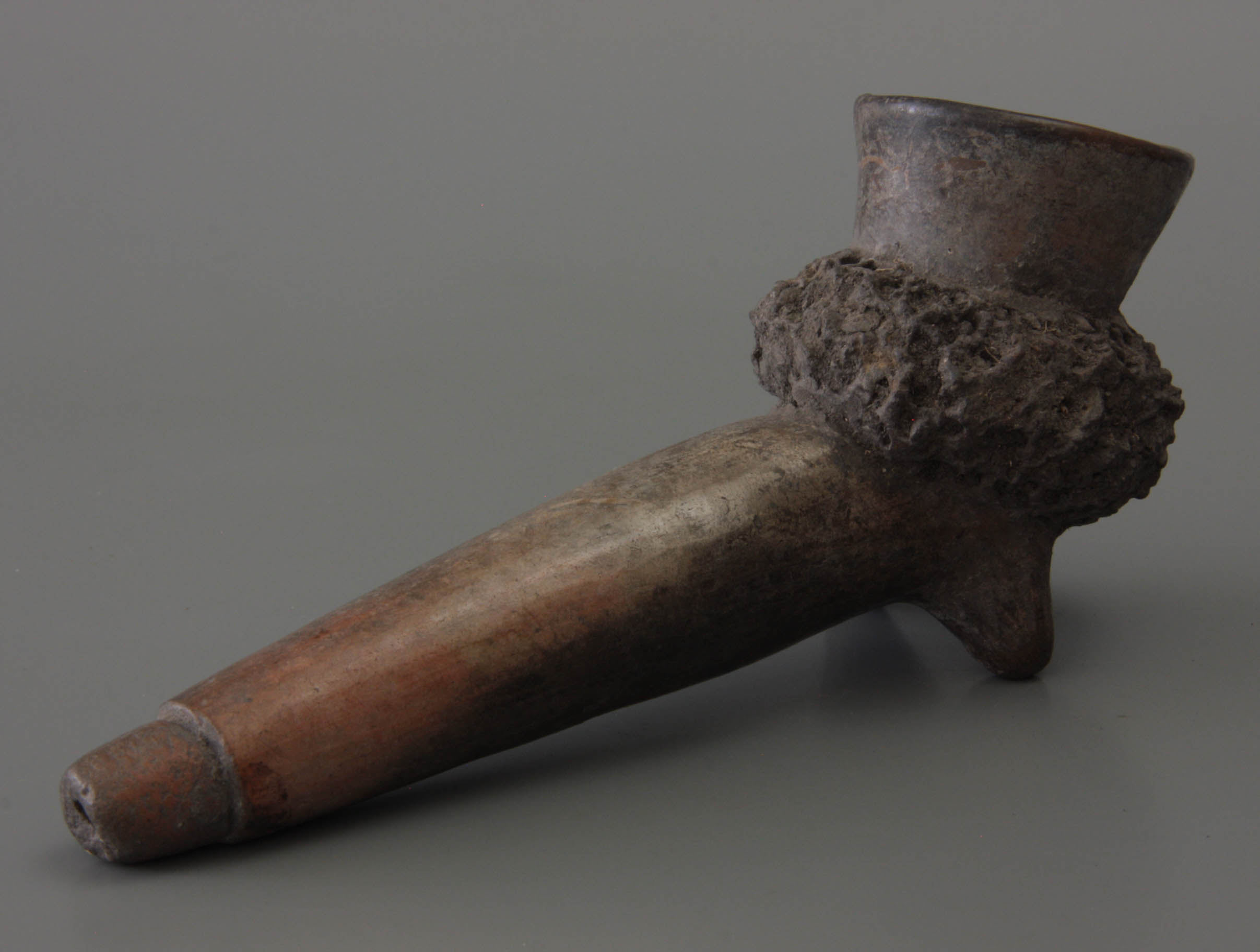
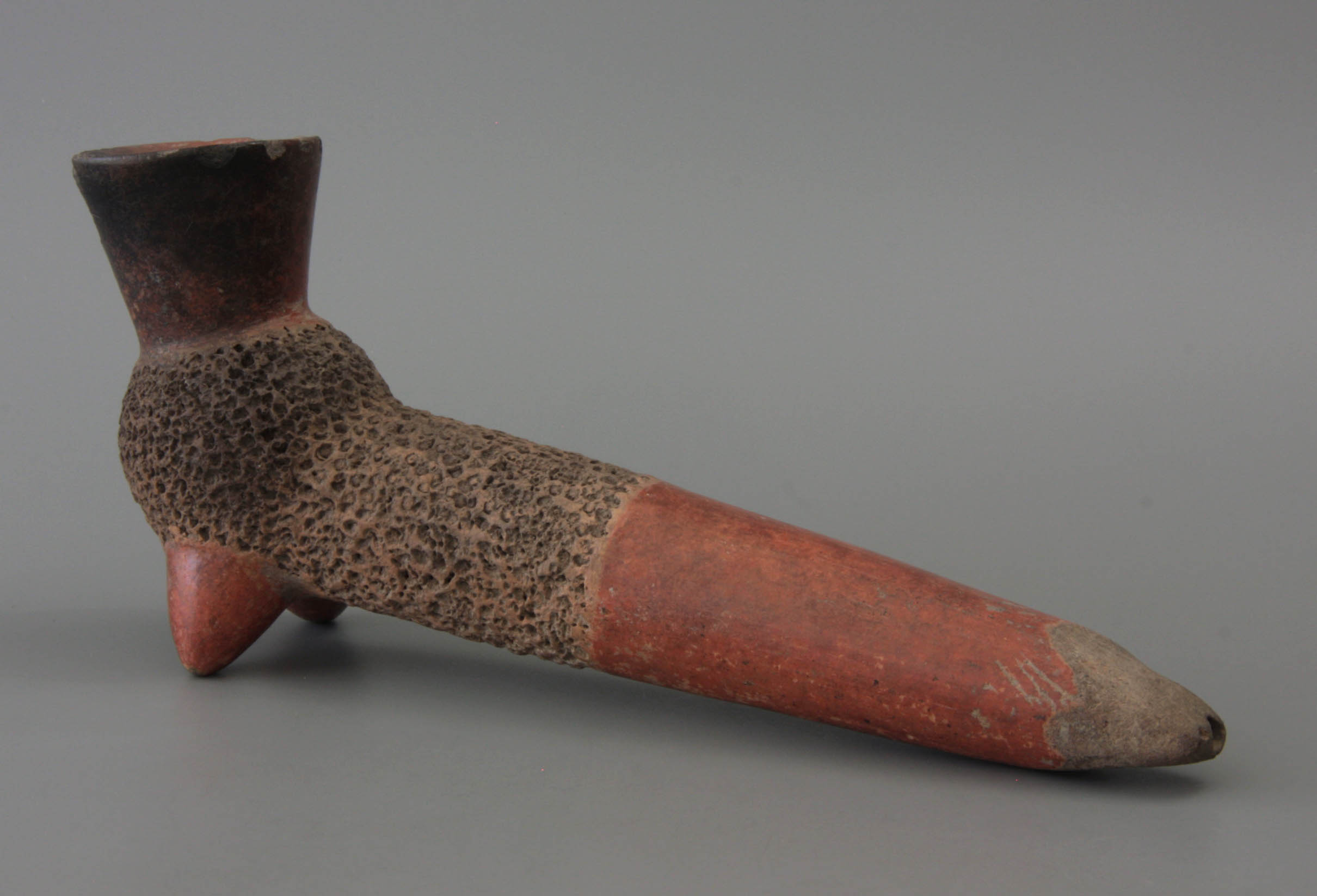
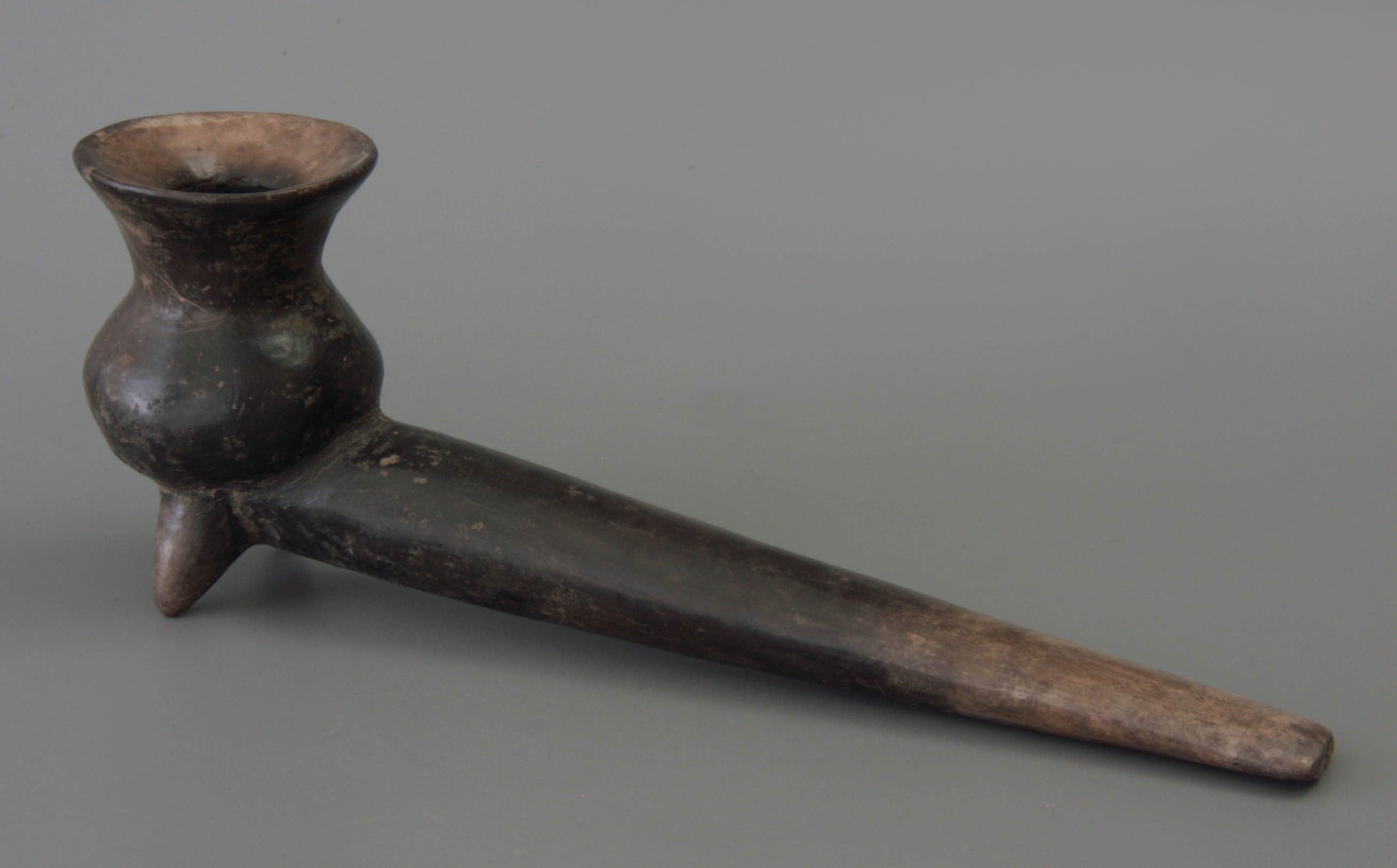
Just as the tobacco pipes give an impression of the development of the smoking instrument, the statuette of the smoker gives an impression of the actual use of the tobacco. This representation of a smoker from the prehistory of tobacco use will only be imitated after many centuries in other cultures. Only when the tobacco was introduced in western Europe at the end of the 16th, early 17th century, smokers are portrayed again. In the meantime, the cultural idea has shifted from the sacred to iconography, because in Western European culture smoking will be associated with the personification of the sense of taste (note 5).
© Don Duco, Pijpenkabinet Foundation, Amsterdam - the Netherlands, 1993.
Illustrations
- Tomb statuette of a smoking figure, terracotta with polished slip. Mexico, South Nayarit, Chapalilla, 200-400 A.D.
Leiden, Pijpenkabinet collections Pk 12.903 - Ceramic tobacco pipe with standing bowl on two feet. Mexico, Colima, 0-300 A.D.
Leiden, Pijpenkabinet collections Pk 8.314 - Tobacco pipe of ceramic with large standing bowl on two feet. Mexico, Tarascan, 900-1500.
Leiden, Pijpenkabinet collections Pk 9.738, Pk 9.739 - Tobacco pipe of ceramic with large standing bowl on two feet. Mexico, Chinesco cultuur, 250-350.
Leiden, Pijpenkabinet collections Pk 11.969 - Tobacco pipe of ceramic with standing bowl in the shape of a cactus. Mexico, Michoacan, Tarascan, 200-400.
Leiden, Pijpenkabinet collections Pk 11.133 - Tobacco pipe of ceramic with standing bowl in the shape of a cactus. Mexico, Michoacan, Tarascan, 800-1200.
Leiden, Pijpenkabinet collections Pk 8.218 - Tobacco pipe of ceramic with standing bowl in the shape of a cactus. Mexico, Michoacan, 800-1500.
Leiden, Pijpenkabinet collections Pk 2.190 - Tobacco pipe of ceramic with standing bowl in the shape of a cactus without details. Mexico, Michoacan, Tarascan, 500-1400.
Leiden, Pijpenkabinet collections Pk 11.131
Notes
- Francis Robicsek, The Smoking Gods, Tobacco in Maya Art, History and Religion, Oklahoma, 1978.
- Dieter Eisleb, Westmexikanische Keramik, Berlin, 1971, p. 10.
- Hasso von Winning, The Shafttomb Figures of West Mexico, Los Angeles, 1974, p. 152, fig. 231.
- José Alcina Franch, Pre-Columbian Art, New York, 1983, p. 465, p. 374, afb. 204. L.A. County Museum of Natural History. Winning, ibidem, p. 155, fig. 242.
- Article first published in Periodiek Vereniging Rembrandt, III-1, 1993